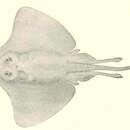The barndoor skate,
Dipturus laevis, is a species of marine cartilaginous fish in the skate family (family Rajidae). It is native to the northwestern Atlantic Ocean, and is found from the Grand Banks of Newfoundland and the southern side of the Gulf of St. Lawrence south to North Carolina. One of the largest skates found in the North Atlantic Ocean, the barndoor skate can reach up to 1.5 meters long. It is carnivorous, feeding on invertebrates and other fish found near the sea floor. While it moves out to sea during warmer months to cooler waters, it does not migrate long distances. The barndoor skate is not specifically targeted by the commercial fishing industry, but it is regularly found amongst by-catch in trawling nets used to harvest other species of fish, and sometimes then used for bait, petfood, or its wings taken for human food. Because of its extremely long life history: slow growth rate, late maturation (often 10 years or older), and small numbers of progeny (average 47 egg cases/year), the barndoor skate population is cited as highly susceptible to fishing pressure, and requires a long period to recover from overfishing. In the 1960s and early 1970s this species suffered a significant decline from overfishing to less than 10% of their 1960 numbers. Barndoor populations increased substantially since 1990; this increase was cited by the National Marine Fisheries Service (NMFS) as reason to preclude it from designation as an endangered species under the Endangered Species Act (ESA) after petitions for its candidacy in 1999 from GreenWorld and the Center for Marine Conservation. In 2003 the conservation status of this species was intensified from vulnerable to endangered by the World Conservation Union (IUCN). It was listed on the Green Peace International Seafood Redlist in 2010 reflecting the unsustainable effect of bottom trawling on this species. (Casey and Myers 1998;
http://www.iucnredlist.org/apps/redlist/details/39771/0;
Federal Register 2002;
Wettstein;
Wikipedia 2012)

